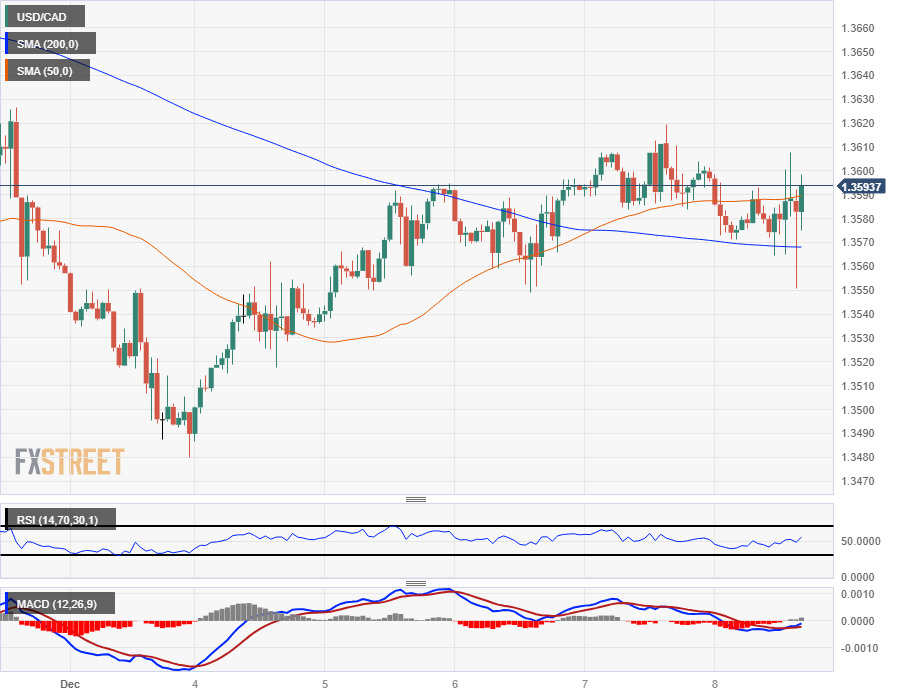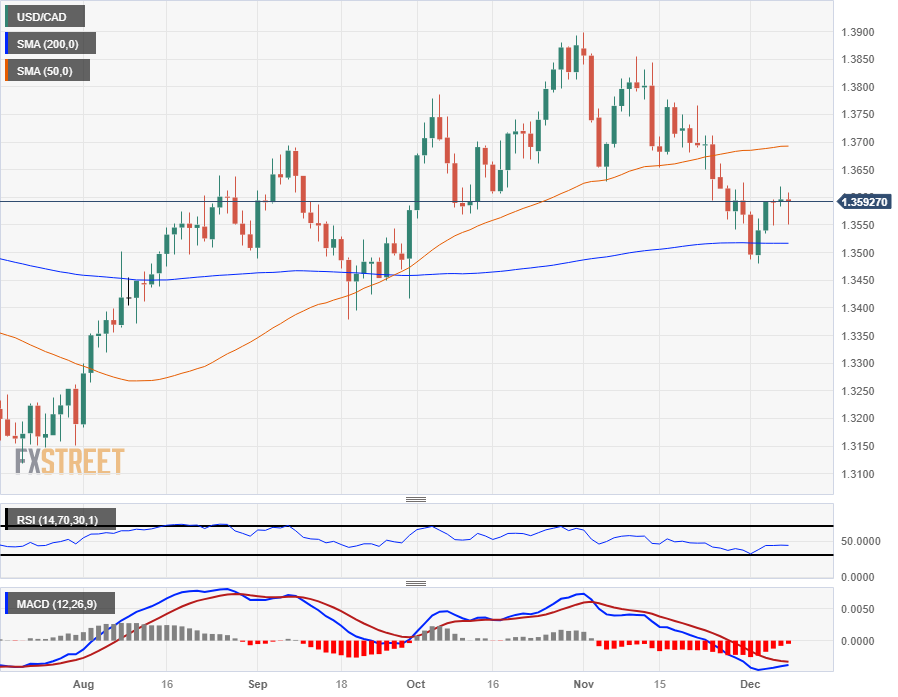- Phân tích
- Tin tức và các công cụ
- Tin tức thị trường
- Canadian Dollar sees a mild Friday recovery amidst choppy post-NFP markets
Canadian Dollar sees a mild Friday recovery amidst choppy post-NFP markets
- The Canadian Dollar follows a broad-market risk bid to higher ground on Friday.
- Economic data from Canada is thin on Friday, as well as all next week.
- Crude Oil takes a little off the top, paring back recent losses and helping to prop up the CAD.
The Canadian Dollar (CAD) is up on Friday, gaining ground across the FX board. Still, gains are thin and the charts remain choppy as investors readjust their positions and expectations after the US Nonfarm Payrolls (NFP) for November surprised to the upside. At the time of writing, the CAD is up a little over a tenth of a percent against the US Dollar (USD), while the Loonie’s strongest performance is against the Kiwi (NZD), climbing over seven-tenths of a percent.
Canada brings little significant economic data on Friday, and the same rings true for next week with next to nothing on the calendar docket for the CAD until next Friday’s appearance from Bank of Canada (BoC) Governor Tiff Macklem. BoC Governor Macklem is expected to answer audience questions after speaking at the Canadian Club of Toronto.
Daily Digest Market Movers: Canadian Dollar in the green for Friday despite rough ride from US NFP
- The Canadian Dollar is up across the broader FX market on Friday, gaining ground against every other major currency, with the US Dollar taking a tight second place.
- The US Dollar climbed ahead of Friday’s US Nonfarm Payrolls before falling back post-release.
- US November NFP figure beats expectations on Friday, coming in at a hair under 200K, well above the forecast for 180K and clearing further ground above October’s 150K showing.
- Despite the swing in risk sentiment after a better-than-expected NFP print, investors will be keeping a close eye on recent figures heading into 2024 and be on the lookout for revisions.
- Of the last twelve consecutive NFP releases, all but four have been revised lower after the fact. Of the four, only two were revised higher; the two most recent prints have yet to fall under the red pen’s stroke.
- The University of Michigan’s Consumer Sentiment Index also came in well above expectations, printing at 69.4, well above the forecasted 62.0 and climbing even further above November’s print of 61.3.
- Next week brings US Consumer Price Index (CPI) inflation figures as well as the Federal Reserve’s (Fed) final Interest Rate Decision, and markets will be keen to see what updates are made to the Fed’s ‘dot plot’ of interest rate projections.
- Crude Oil is seeing a moderate bounceback after declining through most of the week. West Texas Intermediate (WTI) Crude Oil has climbed back to $71.50 per barrel on Friday after declining nearly 8% from Monday’s opening bids, falling to $69.01 per barrel on Thursday.
- A rebound in Crude Oil, even a thin one, is a welcome bump for the Canadian Dollar, which is still down eight-tenths of a percent against the US Dollar from Monday’s open.
Canadian Dollar price today
The table below shows the percentage change of Canadian Dollar (CAD) against listed major currencies today. Canadian Dollar was the strongest against the New Zealand Dollar.
| USD | EUR | GBP | CAD | AUD | JPY | NZD | CHF | |
| USD | 0.19% | 0.30% | -0.13% | 0.11% | 0.10% | 0.57% | 0.44% | |
| EUR | -0.21% | 0.09% | -0.32% | -0.09% | -0.10% | 0.37% | 0.26% | |
| GBP | -0.33% | -0.14% | -0.47% | -0.23% | -0.24% | 0.23% | 0.12% | |
| CAD | 0.14% | 0.32% | 0.45% | 0.25% | 0.23% | 0.71% | 0.58% | |
| AUD | -0.11% | 0.09% | 0.21% | -0.24% | 0.00% | 0.46% | 0.35% | |
| JPY | -0.10% | 0.11% | 0.23% | -0.24% | 0.01% | 0.49% | 0.36% | |
| NZD | -0.56% | -0.37% | -0.25% | -0.70% | -0.45% | -0.47% | -0.10% | |
| CHF | -0.46% | -0.26% | -0.15% | -0.62% | -0.36% | -0.37% | 0.10% |
The heat map shows percentage changes of major currencies against each other. The base currency is picked from the left column, while the quote currency is picked from the top row. For example, if you pick the Euro from the left column and move along the horizontal line to the Japanese Yen, the percentage change displayed in the box will represent EUR (base)/JPY (quote).
Technical Analysis: Canadian Dollar looking for gains on Monday, USD/CAD hampered by 1.3600
The USD/CAD saw some back-and-forth action on Friday, pointing to 1.3550 before rallying back towards the 1.3600 handle. Intraday action is getting squeezed into the midrange, with technical support coming from the 200-hour Simple Moving Average (SMA) near 1.3570.
Bullish momentum looks set to stall after a bounce from the 200-day SMA just above the 1.3500 handle, and daily candles have been closing in the middle for the back half of the trading week.
A bullish break will take the USD/CAD back toward the 50-day SMA near 1.3700, while a downside retest of the 200-day SMA will clear the way for another bearish run at September’s swing lows into 1.3400.
USD/CAD Hourly Chart

USD/CAD Daily Chart

Canadian Dollar FAQs
What key factors drive the Canadian Dollar?
The key factors driving the Canadian Dollar (CAD) are the level of interest rates set by the Bank of Canada (BoC), the price of Oil, Canada’s largest export, the health of its economy, inflation and the Trade Balance, which is the difference between the value of Canada’s exports versus its imports. Other factors include market sentiment – whether investors are taking on more risky assets (risk-on) or seeking safe-havens (risk-off) – with risk-on being CAD-positive. As its largest trading partner, the health of the US economy is also a key factor influencing the Canadian Dollar.
How do the decisions of the Bank of Canada impact the Canadian Dollar?
The Bank of Canada (BoC) has a significant influence on the Canadian Dollar by setting the level of interest rates that banks can lend to one another. This influences the level of interest rates for everyone. The main goal of the BoC is to maintain inflation at 1-3% by adjusting interest rates up or down. Relatively higher interest rates tend to be positive for the CAD. The Bank of Canada can also use quantitative easing and tightening to influence credit conditions, with the former CAD-negative and the latter CAD-positive.
How does the price of Oil impact the Canadian Dollar?
The price of Oil is a key factor impacting the value of the Canadian Dollar. Petroleum is Canada’s biggest export, so Oil price tends to have an immediate impact on the CAD value. Generally, if Oil price rises CAD also goes up, as aggregate demand for the currency increases. The opposite is the case if the price of Oil falls. Higher Oil prices also tend to result in a greater likelihood of a positive Trade Balance, which is also supportive of the CAD.
How does inflation data impact the value of the Canadian Dollar?
While inflation had always traditionally been thought of as a negative factor for a currency since it lowers the value of money, the opposite has actually been the case in modern times with the relaxation of cross-border capital controls. Higher inflation tends to lead central banks to put up interest rates which attracts more capital inflows from global investors seeking a lucrative place to keep their money. This increases demand for the local currency, which in Canada’s case is the Canadian Dollar.
How does economic data influence the value of the Canadian Dollar?
Macroeconomic data releases gauge the health of the economy and can have an impact on the Canadian Dollar. Indicators such as GDP, Manufacturing and Services PMIs, employment, and consumer sentiment surveys can all influence the direction of the CAD. A strong economy is good for the Canadian Dollar. Not only does it attract more foreign investment but it may encourage the Bank of Canada to put up interest rates, leading to a stronger currency. If economic data is weak, however, the CAD is likely to fall.
© 2000-2024. Bản quyền Teletrade.
Trang web này được quản lý bởi Teletrade D.J. LLC 2351 LLC 2022 (Euro House, Richmond Hill Road, Kingstown, VC0100, St. Vincent and the Grenadines).
Thông tin trên trang web không phải là cơ sở để đưa ra quyết định đầu tư và chỉ được cung cấp cho mục đích làm quen.
Giao dịch trên thị trường tài chính (đặc biệt là giao dịch sử dụng các công cụ biên) mở ra những cơ hội lớn và tạo điều kiện cho các nhà đầu tư sẵn sàng mạo hiểm để thu lợi nhuận, tuy nhiên nó mang trong mình nguy cơ rủi ro khá cao. Chính vì vậy trước khi tiến hành giao dịch cần phải xem xét mọi mặt vấn đề chấp nhận tiến hành giao dịch cụ thể xét theo quan điểm của nguồn lực tài chính sẵn có và mức độ am hiểu thị trường tài chính.
Sử dụng thông tin: sử dụng toàn bộ hay riêng biệt các dữ liệu trên trang web của công ty TeleTrade như một nguồn cung cấp thông tin nhất định. Việc sử dụng tư liệu từ trang web cần kèm theo liên kết đến trang teletrade.vn. Việc tự động thu thập số liệu cũng như thông tin từ trang web TeleTrade đều không được phép.
Xin vui lòng liên hệ với pr@teletrade.global nếu có câu hỏi.















